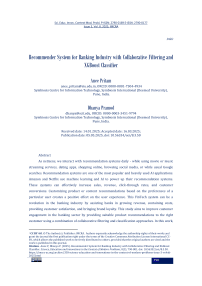Recommender System for Banking Industry with Collaborative Filtering and XGBoost Classifier
Автор: Anee P., Dhanya P.
Журнал: Science, Education and Innovations in the Context of Modern Problems @imcra
Статья в выпуске: 3 vol.8, 2025 года.
Бесплатный доступ
As netizens, we interact with recommendation systems daily - while using movie or music streaming services, dating apps, shopping online, browsing social media, or while usual Google searches. Recommendation systems are one of the most popular and heavily used AI applications. Amazon and Netflix use machine learning and AI to power up their recommendation systems. These systems can effectively increase sales, revenue, click-through rates, and customer conversions. Customizing product or content recommendations based on the preferences of a particular user creates a positive effect on the user experience. This FinTech system can be a revolution in the banking industry by assisting banks in growing revenue, containing costs, providing customer satisfaction, and bringing brand loyalty. This study aims to improve customer engagement in the banking sector by providing suitable product recommendations to the right customer using a combination of collaborative filtering and classification approaches. In this work, a hybrid recommendation model is proposed to provide recommendations to banks' banking clients. The model is built on a Python environment to address various challenges related to recommendation systems in the banking industry.
Netizens, Recommendation Systems, Click-through Rates, FinTech, Banking Industry, Customer Satisfaction, Brand Loyalty, AI, Collaborative Filtering, Classification
Короткий адрес: https://sciup.org/16010524
IDR: 16010524 | DOI: 10.56334/sei/8.3.50
Текст научной статьи Recommender System for Banking Industry with Collaborative Filtering and XGBoost Classifier
Recommendation systems enable companies to change the way customers interact with websites and other online platforms. This, in turn, helps the companies to increase their ROIsby increasing customer conversions and user click-through rates. Amazon and Netflix use these tools to power up their business and provide personalized customer experiences. Customer demographic details are collected and analyzed to garner information regarding past purchases, product reviews, and customer behavior. Such information is used to assess how customers rate the relevant product sets or the possibility of purchasing an additional product.There are different types of recommendation systems. Other approaches are associated with each recommendation system.
Collaborative Filtering: It collects customer ratings for items and computes the similarity between them for recommending products. For instance, if person A likes iPhone and person B likes iPhone and OnePlus, person A will even like OnePlus.
Content-based Filtering: It recommends products to a user which have similar features to those purchased before. User interaction with products is not necessary as the recommendation is made purely based on product-related features.
Demographic-based Recommendation System: Demographic variables classify users into different segments, and products are recommended based on segments. Rating history of users is not required in this system.
Utility-based Recommendation System: Each customer's utility is calculated for recommending products. Utility function depends on the industry. Its advantage over a contentbased recommendation system is that it is independent of product features.
Knowledge-based Recommendation System: Recommendations are made based on the demands and choices of customers. A user's requirements are matched with well-suited products using knowledge-based functions.
Hybrid Recommendation System: A conglomeration of any two recommendation systems described above can be called a hybrid system. It has added advantage of eliminating limitations of one recommendation system [3]. Companies in many industries have begun implementing recommendation systems to retain customers, improve the online shopping experience and increase sales. Business owners have recognized the ability to gather large amounts of information related to transactions and user buying patterns. Future interactions can be fruitful if systematic storage ofsuch information is done continuously.

In addition to improving the customer experience, the information collected can also be used as an advertising targeting tool. Advertising exchanges can have the ability to target other customers on the company website depending on user interactions by including a referral system.
Basic strategies like linking product recommendations related to verified purchases, gathering information about abandoned shopping carts, sharing trending products and purchase history of other customers, and making personalized recommendations can increase revenue to a great extent.
Stimulating e-mails based on online interactions is another way to make the most of information. For example, the company may e-mail a customer who views five phone pages with a coupon code to persuade them to purchase the product. Businesses can use reverse triggers via emails to target products that customers do not yet see.
The demand for recommendation engines is growing with the availability of more and more products online. They help increase sales and customer interactions and ensure customer loyalty by recommending personalized products in real-time. The recommendation engine is not that widely used in the banking industry. This study can be a game-changer in the fintech world.AI based hybrid approaches combining collaborative filtering and classification techniques to recommend appropriate products and services to customers. Personalization and customization can be taken to the subsequent level with a suitable recommendation approach for banks' customers. Research work aims to highlight the importance of recommendation engines for the banking domain. It can help increase the revenue of banks and improve customer satisfaction by recommending products and services of interest. Customer-centric or Product-centric offerings can be made based on past transactions and profiles of the customers. Highly appealing offers can increase retention rates and attract more customers. Such systems can improve with time and the use of other advanced machine learning algorithms.


